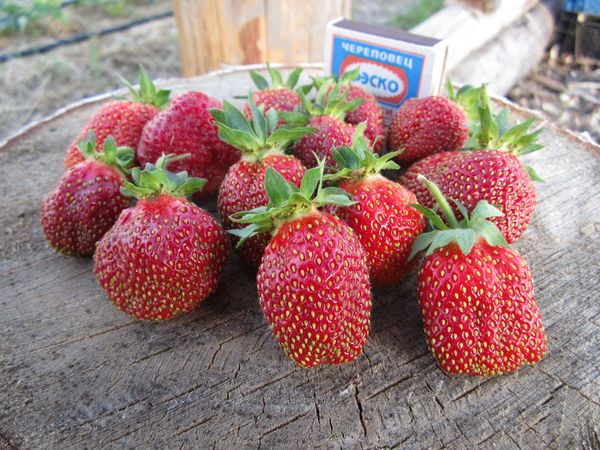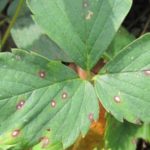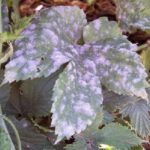Strawberry Maryshka is a large-fruited berry with the aroma of wild strawberry.
Table of contents
Description strawberry varieties Maryshka
Strawberry Maryshka was bred in the Czech Republic. This is a medium early variety. Berries ripen on June 15th. In Siberia and the Urals, it is not planted.
Characteristic berries
Due to the fact that the berries on the bush are located close to each other, they different shapes. They can be in the form of flat or elongated cones.Basically the seeds are located at the very tips, they are yellow, protrude on the surface.
Berries are dark scarlet, dry. Their weight is 40–60 g. Up to 0.5 kg of fruits can be removed from a bush. To taste the berries are sweet, have a flavor, very similar to the smell of wild strawberries. The flesh is thick.
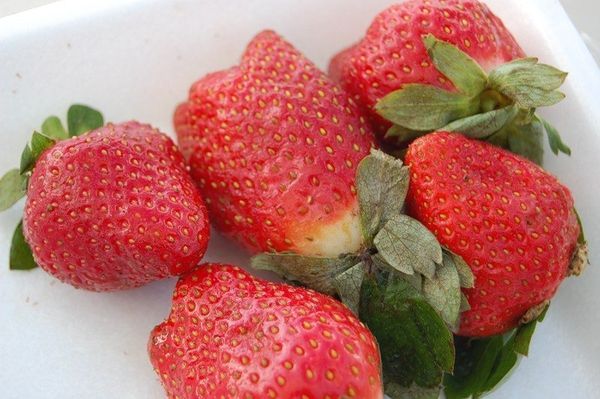
Characteristics of the bushes
Bushes low, few leaves. The leaves are large, emerald. Inflorescences grow over the leaves, under the weight of the berries, they do not bend down to the soil. Flowers combined into clusters.
Advantages:
- Berries of sweet taste, sweet, with the aroma of wild strawberry.
- They don't shrink over time.
- Peduncles are above the leaves, so the berries do not fall on the soil.
- Shrubs have good resistance to diseases, including to gray rot.
- Since the flesh is dense, the berries are easy to transport.
- Sort has good frost resistancesufficient for central Russia.
Disadvantages:
- Frost resistance is insufficient for Siberia and the Urals.
- Sort unstable to red root rot.
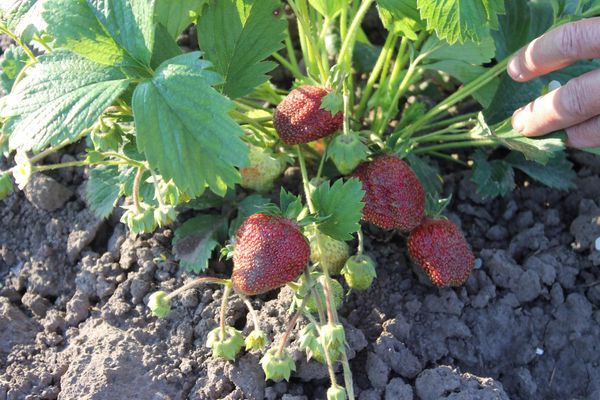
Planting and cultivation
Selection of seedlings
Inspect the seedlings, on the leaves and stems should be no spots, points, mechanical damage. Their shade should be bright emerald, without whitish specks, and the leaves are smooth, not shriveled. Root length - 7 cm.
Selection of land for landing
Strawberries plant well after cereal and onion plants. Bushes need a place lit by the bright rays of the sun, otherwise the sugar content and the number of berries will decrease.
Plants cannot stand moisture stagnation. If there is a danger of flooding of landings at the chosen place, then it is better to make a drainage or bulk hills. Otherwise, the strawberries will hurt gray rot. She needed loam with weak acid characteristics, pH 5.5-6.

How to prepare the soil
If you plant bushes in the spring, then prepare the land in the fall, and if in the fall, then dig and fertilize in the spring.
First, scatter the compost or humus 5–7 kg, 45 g of superphosphate and 45 g of potassium sulfate per 1 m²,Dig the ground to the depth of a shovel. Remove all weeds and roots.. Instead of these fertilizers, you can pour Kemira at a rate of 60-80 g per 1 m².
How and when to plant
In the spring, pickled plants are planted. April 25-30 or May, the soil should warm to a depth of 5–6 cm. It is planted in autumn in September.
Before planting, the roots are dipped in a solution of 7 g of Agat 25K and a liter of water or in a solution of 15 g of Humate K and 1 l of water.
Sockets before disembarking soaked in a solution of 1 part of copper sulphate and 6 parts of soda. Further, in a ten-liter bucket of water pour 30 g of the compound from copper sulphate and soda. This compound disinfects bushes and protects against fungal diseases.
Dig holes, observing the indentation between them 0.3-0.4 m. Rows between 60 and 70 cm are made. When planting, the heart cannot be buried or raised, or when it is deepened, it will rot and dry when raised.
Growing points
Immediately after planting, the strawberries are watered daily throughout the week at a rate of 2-3 liters per 1 m². After a week, you can already water it much less often - once a week. Pour strawberries with a little water. Do it in the early morning or late evening.
After watering, loosen the ground, pluck the weeds. To protect against weeds, strawberries can be covered with a spunboid by cutting holes in the bushes in it.
In the spring cut off old or dry leavesFrom the beds remove the top layer of soil 3 cm thick, trying not to damage the roots. This eliminates overwintered pests. The beds are loosened. After the ground, if it was not covered with a spunboid, sprinkle with straw and peat.
Feed strawberries in the second year after landing. In the spring, they make a solution from 1 part of mullein and 4-5 parts of water or from complex mineral fertilizer - nitrophos, pouring 1 tbsp. spoon in a ten-liter bucket of water.
A solution of fertilizer is watered 1 time in 10 days, do it until the bushes bloom. When flowering and fruit formation strawberries are not fertilized.

After picking the berries, it is necessary to make abundant watering. In mid-September, the plants are fed: 2 tbsp. spoons of nitroammofoski are poured into a ten-liter bucket of water, a glass of wood ash, 30 g of potassium sulfate is poured there.
From the end of August to the middle of September cut off all diseased, dried leaves. Periodically cut the mustache.In late September or early October, the land is mulched with peat.
In winter, strawberries can be covered with spruce branches. The main thing - to open the strawberries in the early spring, otherwise the plants will vperet.
Breeding methods
Usa
Closer to the fall, the ends of the whiskers are cut off from the strongest bushes, leaving 2-3 “kids” each. Then the children are separated from the mother plant, cutting off the mustache and put on a new place.
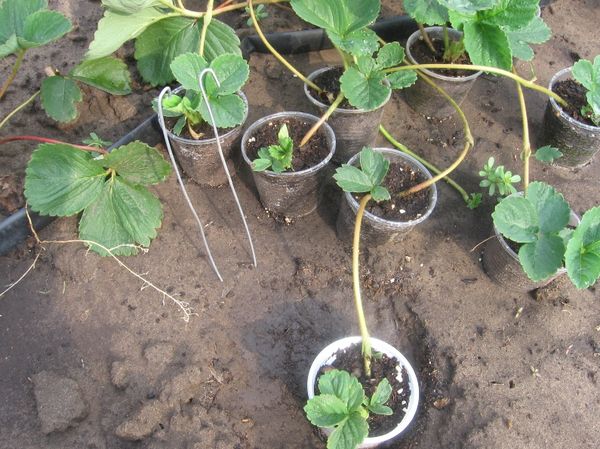
Dividing bush
The strongest the plants are carefully dug and divided, leaving a bud or growing point. The cut is best treated with antiseptics and sprinkled with ash, so that the strawberries do not get rotten rot.
Diseases and pests
Red root rot occurs when an improperly selected landing area, if the ground is wet and not sufficiently illuminated. When the disease leaves become yellow, and after dry. The roots are made dark. Sick bushes dig.
From angular spotting leaves are sprayed with strawberry bordeaux liquid: make a concentration of 3-4% and use until the beginning of the growing season in early spring. And before flowering and after picking the berries, Bordeaux liquid concentration is 1% and the bushes are sprayed.
- Angular spotting
- Mealy dew
In early spring when powdery mildew make an emulsion of 20 g of soap and copper sulfate on 1 liter of clean water and spray the bushes as described.
After picking berries when attacking strawberries weevils, whitefly, strawberry beetles, flares Prepare a solution of malathion. Sprayed on a day when there is no rain and wind, and the air temperature is no higher than + 15º C.
So, having planted strawberry maryshka and carefully caring for it, you will reap the berry, which is considered the sweetest and driest compared to the berries from other varieties.
